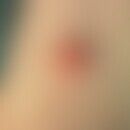Synonym(s)
HistoryThis section has been translated automatically.
Walker and Clodius 1963; Rüdiger, 1970
DefinitionThis section has been translated automatically.
Rare, severe, congenital, ectodermal dysplasia syndrome with, among other things, congenital absence of fingers or toes (split hand/foot = ectrodactyly), cleft palate and ectodermal dysplasia.
You might also be interested in
EtiopathogenesisThis section has been translated automatically.
Evidence of autosomal-dominant inherited mutations of the TP63 gene (3q28). See also ADULT syndrome.
ClinicThis section has been translated automatically.
There may be considerable differences in the appearance and severity of the syndrome (mild manifestations to full-blown with all possible disorders).
Cleft palate or cleft lip and palate. Mostly cleft hand and cleft foot. Nail dysplasia, hypoplasia of the nipples, hearing loss.
Eye: atresia of nasolacrimal ducts, photophobia, chronic blepharitis and conjunctivitis, dacryocystitis, blepharophimosis, blue iris (pigment deficiency).
Mouth: partial anodontia or microdontia, especially sift-like expression of incisors.
Nails: nail dysplasia
Hair: blond, sparse, curly; hypoplasia of brows and eyelashes, atrophy.
In later life folliculitis-decalvans-like inflammation of the hair base with consecutive scarring alopecia(pseudopelade).
DiagnosisThis section has been translated automatically.
TherapyThis section has been translated automatically.
Case report(s)This section has been translated automatically.
Two boys and their mother were affected.
Patient 1 (12 years) had a mild bilateral syndactyly between the 3rd and 4th finger, a cleft palate which had been surgically repaired, hypodontia and enamel anomalies with pronounced caries. The hair was sparse, light and thin, the nails were thin and had transverse grooves. The skin was dry and there was a mild hypohidrosis. Due to a lacrimal duct atresia, keratoconjunctivitis occurred repeatedly. In addition there were anomalies of the genitourinary tract with hypospadias and left-sided cryptorchidism. In addition there was conductive hearing loss and a slight auricular dysplasia.
Patient 2 was his 10-year-old brother with also light hair, dental anomalies, unilateral cleft palate and a lacrimal canal atresia. The patient also had an increasing conductive hearing loss.
The 40-year-old mother suffered from a left-footed ectodactyly and an almost complete cutaneous syndactyly between the 4th and 5th finger of the right hand. The hair was also quite light, showing sparse growth. The nails were hypoplastic. Furthermore, a partial anodontia was visible, but without cleft formation. There were recurrent eye infections, because the patient also had a bilateral lacrimal duct closure, which made a corneal transplantation necessary at the age of 28 years.
All patients showed normal mental development.
LiteratureThis section has been translated automatically.
- Bigata X et al (2003) The ectrodactyly-ectodermal dysplasia-clefting syndrome (EEC): report of five cases. Pediatr Dermatol 20: 113-118
- Glorio R et al (2003) Ectrodactyly, ectodermal dysplasia and clefting (EEC) syndrome. J Eur Acad Dermatol Venereol 17: 356-358.
- Hamada T et al. (2002) Common mutations in Arg 304 of the p63 gene in ectrodactyly, ectodermal dysplasia, clefting syndrome: lack of genotype-phenotype correlation and implications for mutation detection strategies. J Invest Dermatol 119: 1202-1203
- Rüdiger RA, Haase E, Passarge E (1970) Association of ectrodactyly, ectodermal dysplasia and cleft lip-palate. The EEC syndrome. Am J Dis Child 120: 160-163
- South AP et al (2003) EEC (Ectrodactyly, Ectodermal dysplasia, Clefting) syndrome: heterozygous mutation in the p63 gene (R279H) and DNA-based prenatal diagnosis. Br J Dermatol 146: 216-220
Incoming links (4)
Adult syndrome; Anonychia-electrodactyly syndrome; Ectodermal dysplasia ; Hay-wells syndrome;Disclaimer
Please ask your physician for a reliable diagnosis. This website is only meant as a reference.




